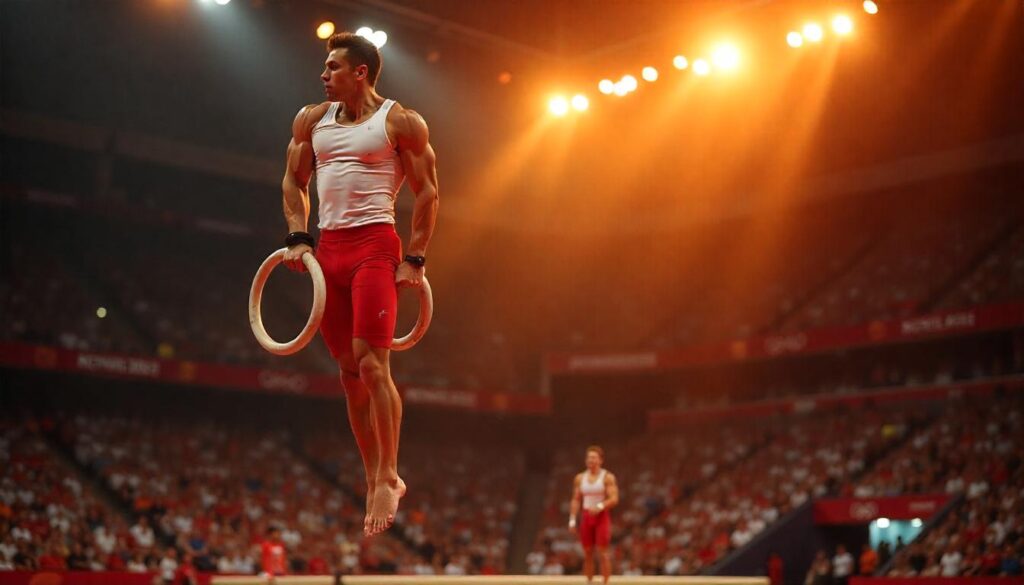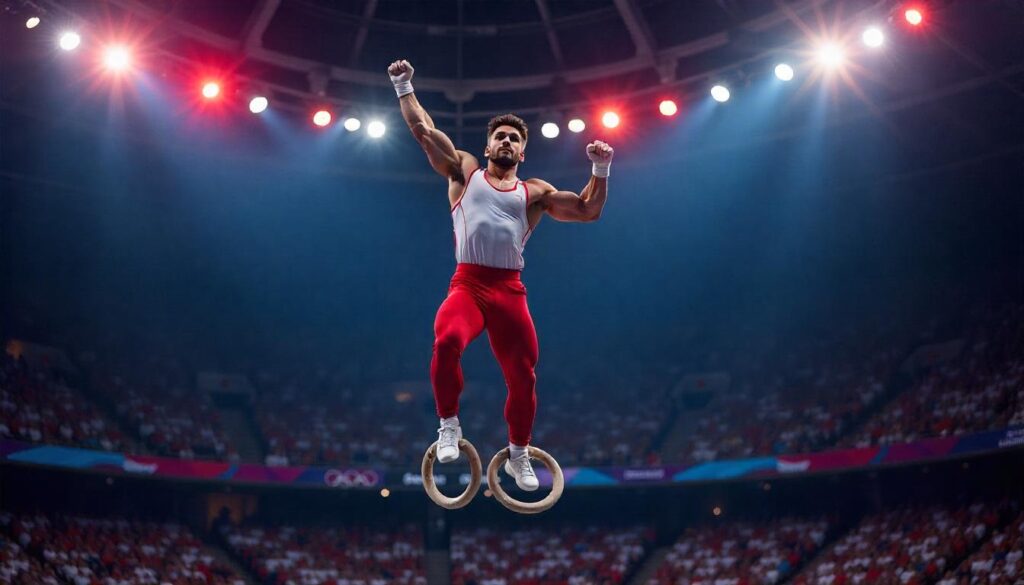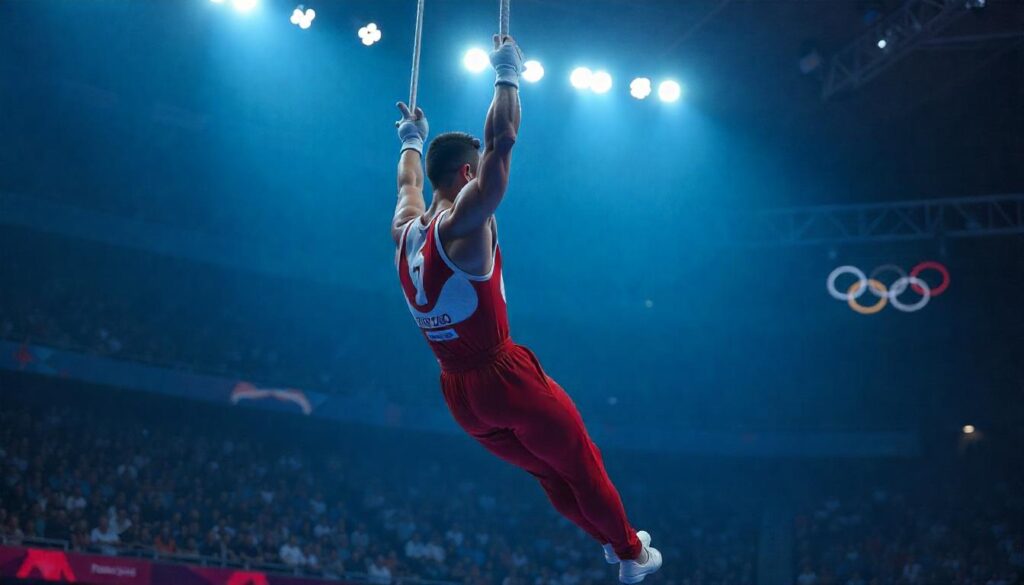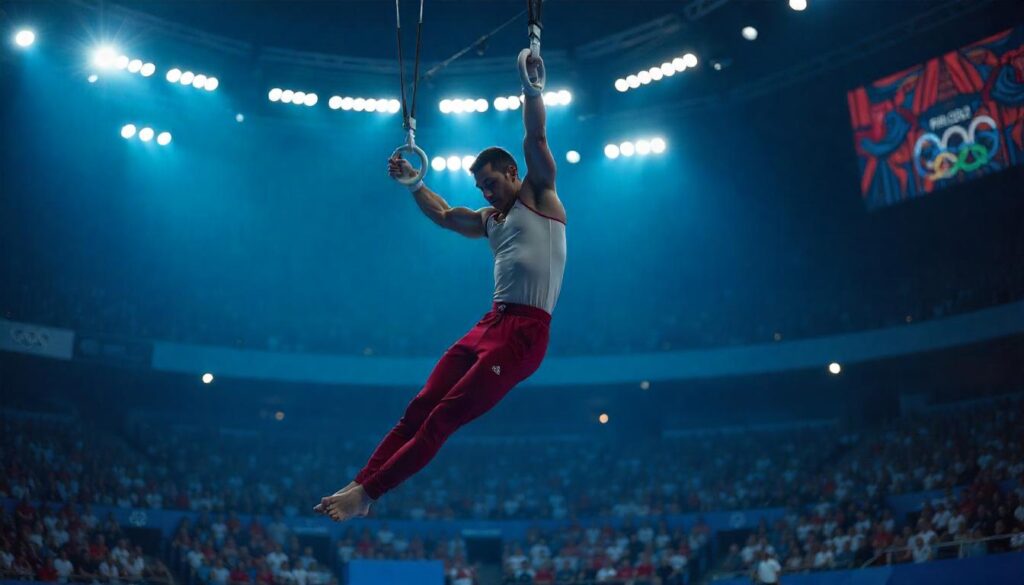Imagine this: a packed Olympic arena. The crowd falls silent. A gymnast, chalk-dusted hands trembling slightly, grips two rings suspended high above the mat. Then—control, precision, and brute strength. He lifts himself into a perfect Iron Cross, body steady as stone, arms outstretched like wings. No sound but the creak of the cables. This is the still rings event at the Olympics—one of the most breathtaking, underrated, and downright grueling spectacles in all of sports.
So what makes the gymnastics rings at the Olympics such a powerful draw, even among casual viewers? Why are they known as the ultimate test of upper body strength and control? And how did this humble apparatus evolve into one of the most dramatic moments of every Summer Games?
Let’s swing into it.
A Brief History of Olympic Gymnastics Rings
The rings have been part of Olympic history since the very first modern Games in Athens, 1896. Known formally as “still rings,” the event is unique to men’s artistic gymnastics. Women don’t compete on the rings at the Olympics—a fact that’s as much about tradition as it is about the sheer, intense upper-body power required for the event.
Back in the early 20th century, routines were simpler. The focus was on clean holds and basic swings. Fast forward to Paris 2024, and you’ve got elite athletes like Liu Yang of China performing complex strength elements and fluid transitions that push the boundaries of human capability.

Biography Table: Gymnastics Rings Olympics
| Field | Information |
|---|---|
| Event Name | Gymnastics Rings (Men’s Still Rings) |
| Olympic Debut | 1896 (First modern Olympics, Athens) |
| Gender Category | Men only (as of 2024 Olympics) |
| Apparatus Material | Laminated wood or metal |
| Dimensions | Ring Thickness: 28 mm (1.1 in); Inside Diameter: 18 cm (7.1 in); Height: 2.5 m (8.2 ft); Ring Distance: 50 cm (19.7 in) |
| Most Famous Skill | Iron Cross |
| Notable Olympic Champion | Liu Yang (China) – Gold in Tokyo 2020 and Paris 2024 |
| Other 2024 Medalists | Zou Jingyuan (Silver, China); Eleftherios Petrounias (Bronze, Greece) |
| Top Nation (2024) | China (Gold and Silver at Paris 2024) |
| Scoring System | Based on difficulty (D-score) + execution (E-score) |
| Record Score (2024) | Liu Yang: 15.300 |
| Common Variations | Olympic gymnastics rings, still rings Olympics, men’s rings gymnastics |
| Historical Legend | Akinori Nakayama (Japan) – Back-to-back wins in 1968 and 1972 |
| Current Trend | Post-Paris 2024 focus on LA 2028 prospects |
| Physical Requirements | Extreme upper-body strength, control, and precision |
The Stars of Paris 2024: Liu Yang’s Historic Gold
Speaking of Liu Yang—his performance in Paris wasn’t just gold medal-worthy. It was legendary. The Chinese gymnast scored 15.300, narrowly edging out his compatriot Zou Jingyuan (15.233) and Greece’s beloved Eleftherios Petrounias (15.100).
What made Liu’s win so special? It was his second consecutive Olympic gold on the rings, making him the first man since Japan’s Akinori Nakayama (1968, 1972) to defend his Olympic title in this event. That kind of consistency and dominance is rare, especially in an event where one slight wobble can cost everything.
China’s one-two finish in the still rings final solidified their reputation as the world leaders in men’s gymnastics strength events—a result of rigorous training programs and a long-standing culture of excellence.
Anatomy of the Apparatus: What Are Olympic Gymnastics Rings Made Of?
At first glance, the rings seem simple—two loops hanging from cables. But don’t be fooled. They’re meticulously engineered for both performance and safety.
- Material: Usually wood or coated metal, chosen for grip and slight flexibility.
- Thickness: 28 mm (about 1.1 inches).
- Inside Diameter: 18 cm (7.1 inches).
- Height: Suspended 2.5 meters (8.2 feet) above the floor.
- Distance Apart: 50 cm (19.7 inches) between the rings.
These precise specs are regulated by the International Gymnastics Federation (FIG) and ensure consistency from training gyms to Olympic finals.
What Makes the Rings So Difficult?
If you’ve ever tried to do a simple dip or hold yourself steady on a pair of gymnastic rings, you know how quickly your muscles start to burn. Now imagine doing that while holding your body perfectly horizontal—or even upside down—with your arms locked in place.
The rings require isometric strength—the kind where muscles are contracting but not moving. Think of moves like:
- Iron Cross: Arms stretched straight out at shoulder level, holding the body vertical.
- Planche: A full-body plank with arms locked, legs hovering off the ground.
- Maltese Cross: A lower and wider variation of the Iron Cross—insanely difficult.
And don’t forget: every move must be executed with control, stillness, and grace. Swinging or shaking can result in point deductions.

How Do Judges Score the Rings Event?
Olympic gymnasts are scored based on two primary components:
- Difficulty (D-score): Based on the complexity and risk level of the elements in the routine.
- Execution (E-score): Judges look for form, control, body alignment, and stability.
Even the most daring routine won’t win gold if it’s shaky or unpolished. Liu Yang’s gold-medal performance in Paris 2024 was a masterclass in both difficulty and execution.
Famous Moves: Beyond the Iron Cross
Some of the most iconic moves on the rings are visually arresting and incredibly demanding. Here are a few that wow Olympic judges and fans alike:
- Inverted Cross – Like the Iron Cross but upside down.
- Jonasson – A high-flying dismount with multiple twists.
- Azarian Cross – A transition into the Iron Cross from a swing or inverted position.
Each element is like a signature. When executed perfectly, it not only scores points—it creates moments that live in Olympic highlight reels forever.
The Legends Who’ve Shaped the Event
Still rings may not get the same mainstream love as floor routines or high bar, but the athletes who’ve dominated this event are legends in their own right.
- Akinori Nakayama (Japan): The first man to win back-to-back Olympic golds on the rings (1968, 1972).
- Yuri Chechi (Italy): Nicknamed “The Lord of the Rings,” a five-time world champion and Olympic gold medalist (1996).
- Eleftherios Petrounias (Greece): Known for his clean lines and powerful holds, he’s medaled in three consecutive Olympics.
- Liu Yang (China): The modern-day master of the rings, now a two-time Olympic champion (2020, 2024).
Training Like an Olympic Rings Gymnast
Olympic-level training for the rings isn’t just about brute force—it’s about control, balance, and mental resilience. Gymnasts spend years developing:
- Shoulder stability
- Core strength
- Grip endurance
- Flexibility and mobility
They also work with specialized coaches, sports psychologists, and nutritionists to maintain their peak form. Rings training is often the most punishing part of a gymnast’s regimen.
What’s Next: Eyes on LA 2028
As we look toward the Los Angeles 2028 Olympics, the still rings event is bound to evolve even further. There’s already buzz around new talent rising in Japan, China, and Europe, and potential tweaks to the Code of Points may encourage even more daring routines.
Could Liu Yang go for a three-peat? Will a new legend emerge to challenge China’s dominance?
Only time—and training—will tell.

Final Thoughts: Why Rings Matter
The Olympic gymnastics rings aren’t just an apparatus—they’re a crucible. They test the physical and mental limits of some of the world’s most elite athletes. They create moments of silence, awe, and thunderous applause. And in a sport filled with grace and speed, the still rings demand something different: raw, immovable power.
So next time you’re watching the Olympics, don’t skip the rings final. You might just witness a moment that redefines what the human body can do.

